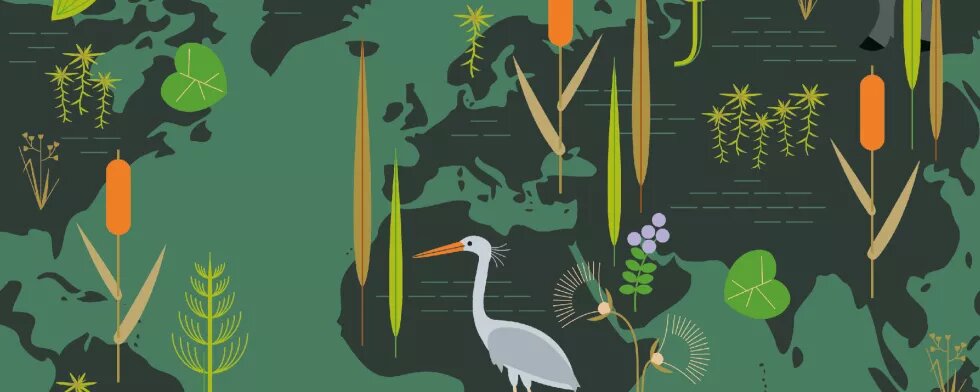Peatlands are a mixture of elements: they are both water and land at the same time. They form where the soil is wet all year round. Waterlogging prevents dead plant material from decomposing, creating their characteristic organic soils over thousands of years. And peatlands can be found all over the world, from the Arctic to Europe and the tropics, all the way to Tierra del Fuego at the tip of South America. They are impressive ecosystems, rich in rare animal and plant species. Their peat soils store enormous amounts of carbon, so they play a decisive role in climate protection – as long as they stay wet.

In the past, people in continental Europe showed a great deal of respect – and sometimes fear – for peatlands. They were shrouded in myth: they were dangerous places, home to mysterious creatures which were better avoided or treated with deference. Then, a few centuries ago, people began to make use of these fascinating watery landscapes, draining bogs and fens to make way for houses, woods and fields.
Today, peatlands provide vital services to the communities that live in and around them: they regulate water levels, maintain water supplies, and moderate floods and droughts. Indigenous communities who have lived in peatlands for generations have deep-rooted cultural ties to the land. They fish, hunt and gather medicinal plants from the peatlands.
But peatlands are still being destroyed all over the world. In Central Europe, well over 90 percent of the peatlands are affected; in the tropics and elsewhere, healthy peatlands are being lost ten times faster than the peat can grow. Agriculture and forestry are the main culprits. In Europe, much of the peatland is used for livestock, particularly for beef and dairy production and for growing fodder. Many governments, and the European Union (EU) through its Common Agricultural Policy (CAP), even subsidize agriculture on drained peatlands. Peatlands are also used to extract peat for fuel and as substrates for horticulture. In the tropics, the destruction of peatlands has proceeded apace, driven by multinationals from the Global North. This has far-reaching consequences for the regions, including the use of fire to clear land for palm oil plantations, and the felling of valuable tropical timber. These peatlands are often peat swamp forests, where giant trees stand on deep layers of peat, so storing large amounts of carbon in the wood and the soil below. Such rainforests provide a refuge for unique plants and animals such as orangutans and lowland gorillas, and at the same time protect people and nature from drought and flooding. All this is now imperilled.
More than 10 percent of the world’s 500 million hectares of peatlands have already been drained, and a further 500,000 hectares are destroyed every year. This destruction is both accelerating species extinction and fuelling the climate crisis. Once they dry out, peatlands change from being carbon sinks to sources of greenhouse gases like carbon dioxide (CO₂). Worldwide, drained peatlands are responsible for around 4 percent of all anthropogenic greenhouse gas emissions, peat fires excluded. Intact peatlands must be kept wet and be protected to prevent further emissions. It is also possible to reduce emissions by rewetting drained peatlands. This preserves the peat and retains the carbon it has built up over centuries.
For far too long, many institutions have ignored what is now widely recognized: protecting and restoring peatlands is an important part of tackling the climate crisis. And therefore, we need a fundamental change in the way peatland is managed. Livestock raising and plantations on drained peatland must be reduced. Alternatives to conventional intensive agriculture are needed to use large areas of wet peatland: alternatives that combine agricultural use with climate and biodiversity protection – such as paludiculture. To make the transition, farmers need certainty and support. Protecting the climate is a task for society as a whole because it is about the preservation of an environment worth living in for everyone.
It is clear that we need more effective and joined up governance of peatlands so that they deliver a triple win for the climate, people and the planet urgently. There is growing awareness of the importance of peatlands with countries and stakeholders adopting peatland-related resolutions under different international frameworks. The sustainable management of peatlands can be included in Nationally Determined Contributions and Long-Term Strategies for the Paris Climate Agreement. Peatlands restoration and conservation can help parties meet targets under the Global Biodiversity Framework and Land Degradation Neutrality principles.
The use of drained peatlands damages the environment and should no longer be subsidized. Instead, we need legally binding targets for peatland restoration and attractive financial support for alternative, wetter uses of agricultural and forestry land. We need to act now. This requires effective incentives, public and private intitiatives and regulatory and planning mechanisms. Relying on voluntary action is no longer enough. In all policy areas, peatland conservation must be considered together with the future prospects of local communities, Indigenous peoples, agriculture and forestry in a regional context. Both policymakers and society as a whole must play their part.
The Peatland Atlas 2023 highlights not only the consequences of the destruction of these unique habitats, but also the potential of wet peatlands for mitigating climate change. It outlines strategies to protect and use them to encourage change by all stakeholders. Climate crisis is not in the future: we are already living through it. Summer droughts and record-breaking heat demand swift and effective action. Peatlands, those natural climate reservoirs, can play a vital role. Peat must be wet!
Dr. Imme Scholz, Heinrich-Böll-Stiftung
Antje von Broock, BUND (Friends of the Earth Germany)
Jan Peters, Michael Succow Stiftung, Partner in the Greifswald Mire Centre
Dianna Kopansky, Global Peatlands Initiative
